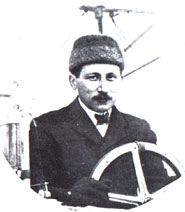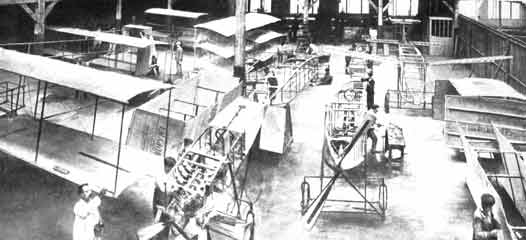



Voisin- 1911 Canard Freres Hydro Seaplane


Designed by Gabriel and Charles Voisin of France, this aircraft type became a popular sight at aerial demonstration meets around the globe.
Despite its marginal controllability, the Voisin set many records, and is largely responsible for creating an interest in aviation amongst all Europeans.
Aircraft designer Henry Farman (responsible for the Farman observation aircraft of World War I), had his earliest flight experiences in Voisin aircraft.
Perhaps the most famous man to ever fly a Voisin was the world renowned escape artist and magician, Harry Houdini, who became the first recorded pilot to ever successfully fly an aircraft in Australia.
I hate to be a nag, but the Concorde was not a canard. It was a plain old delta, with all the attendant faults! It DID stall and crash on takeoff in the case of the French one on 25 July 2000. Course, under the circumstances, probably even a canard would have crashed. Modern day, the Beech Starship and Piaggio Avanti are true canards, and there are a couple of European fighters which are canards, but none like the Voisin was a canard!!! You guys are doing great work! keep it up....Voisin is great! Thanks for all of the terrific mind food! Thanks Chip. An unusual design as well. Phil
"Chip, While impatiently awaiting "The CD" I made this 1911 Voisin canard float plane. The engine is too big because I wanted to use straws. I also cheated and made wing struts out of tooth picks and engine, horiz. tail and vert tail horn out of 1mm carbon fiber. Most of the pictures I have show scalloped wing tail edges. There is also a lot of variability on the pontoon and wheel arrangements. Rich oops. forgot something. Sorry. I just rolled cylinders and longerine out of reg. weight paper." |
Voisin - 1911 Canard

The French were in the air and in the news in the spring of 1908. Gabriel Voison was manufacturing airplanes made to order. He had formed a brief partnership with Louis Bleriot and built two airplanes with him - a biplane glider and a powered biplane. The glider flew poorly and the powered version didn't fly at all, which Voisin blamed on Bleriot's unusual ideas and his erratic approach to aeronautical engineering. Bleriot would try anything, sometimes making drastic changes to the aircraft such as substituting elliptical wings for conventional wings.
The Voisin brothers, had the distinction of being the first commercial
aeroplane manufacturers in Europe when they began selling their popular
biplanes in 1907. Henry Farman was an early customer and several flew
at Rheims in 1909. Voisin machines were characterized by being safe
and stable rather than spectacular in terms of performance, and showed
little development over the years. The wings were of boxkite construction
with a varying number of cells being formed by vertical 'side-curtains'
fitted between the upper and lower wings. The tail unit was another
large boxkite cell. A monoplane forward elevator was mounted on the
front of the fuselage. 
There was no control in roll at all on most Voisin's, and it was hoped by the designers that the wing cells would supply the necessary lateral stability. Construction was from ash and steel tube, with a plain or rubberized cotton covering. The propeller was made from steel shafts, with aluminum blades.
The engine was mounted behind the pilot between the tail booms in a pusher layout. Various power-plants were fitted, including 50 hp versions of the Antoinette, E.N.V, Renault, Vivinus and Gnome, and 60 hp versions of the E.N.V., Gobron and Wolsey. The last standard Voisin left the brothers' factory at Billancourt in 1911, by which time the design was obsolete.
Ferdinand Leon Delagrange (1873-1910) bought one of the first Voisin's at the same as Henry Farman in 1907. In March 1908 he carried the first passenger in Europe, who was Henry Farman himself. He also took up the first woman to fly, Madame Peltier, in July 1908 at Milan. She took several lessons which culminated in piloting the Voisin solo, but she did not take her interest any further.
In 1908, the French pilot Ferdinand Leon Delagrange visited Rome in preparation for flight demonstrations. The airplane manufacturer Gabriel Voisin accompanied him, and Mario Calderara asked Voisin if he could come to Paris and work in his shop as a draftsman and designer. Voisin agreed, and Calderara applied to the Italian Admiralty for a six months leave of absence without pay.
In July 1908 he (Calderara) traveled to Issy Les Moulineaux (near Paris) and worked in the shop of Gabriel Voisin . The two had become very good friends and collaborated on new ideas.
After helping in the design of several airplanes, he was offered by Mr. Ambroise Goupy, a wealthy Frenchman who was interested in flight, the opportunity of designing and manufacturing, funded by Goupy, a new type of flying machine, very light and small: a "tractor propelled biplane", the first of its type. He built the airplane, called "Calderara Goupy" and flew it successfully on March 11th, 1909 in Buc, France.
History
 In 1910 the Voisin company needed a replacement for their famous, but now obsolete,
boxkite-like standard construction. The "box-kite" was modernized,
fitted with ailerons and a simplified tail-unit, and the front elevator was
discarded. This model then became the direct progenitor of the Voisin world
war 1 bombers. But aside of this evolution, one also experimented with totally
new types. One of these, which was to become quite successful, was the Voisin
Canard.
In 1910 the Voisin company needed a replacement for their famous, but now obsolete,
boxkite-like standard construction. The "box-kite" was modernized,
fitted with ailerons and a simplified tail-unit, and the front elevator was
discarded. This model then became the direct progenitor of the Voisin world
war 1 bombers. But aside of this evolution, one also experimented with totally
new types. One of these, which was to become quite successful, was the Voisin
Canard.
The first of these planes was tested in late 1910, and it had been put together from existing parts, the fuselage reportedly coming from an old triplane. The wingspan was 36', and it was powered by a 50 hp Rossel-Peugeot rotary engine. A 3-view of this machine is found in The Aero, 11 Jan 1911.
It does however
appear to be rather inaccurate (not an unknown problem with early scale drawings)
when compared with photos of (presumably) the same plane. The fuselage was uncovered,
and the wings were set with some dihedral. In common with other landplane Voisin
Canards the nose wheels are put directly under th e fuselage, so when at rest
it assumes a very strange looking nose down attitude.
e fuselage, so when at rest
it assumes a very strange looking nose down attitude.
Other Canards followed, now with covered fuselages and wings without dihedral. Instead the wings were provided with side panels, as in the early boxkite Voisin's. In The Areo, July 1911, is found a 3-view of a two-seat landplane of this type.
In 1911, seaplanes were a novelty which attracted much attention, and it was decided to put floats on the Canard. This resulted in the Voisin Hydro Canard I. It was flown by Maurice Colliex from the Seine near Billancourt. In August 1911, one had fitted a Canard with both wheels and floats, and Colliex made a flight from Issy to the Seine and back, which got some attention.
Later models featured a fixed stabilizer with separate elevators. This assembly was of broader chord than the earlier all flying elevator. A plane of this configuration which took part in the 1912 Monaco sea plane meeting, again piloted by Colliex and had four floats instead of the usual three. A similar looking machine was bought by the French navy as their first aeroplane.







Specifications for the Voisin Canard
 |
Span 32 ft.10 in. Performance |



